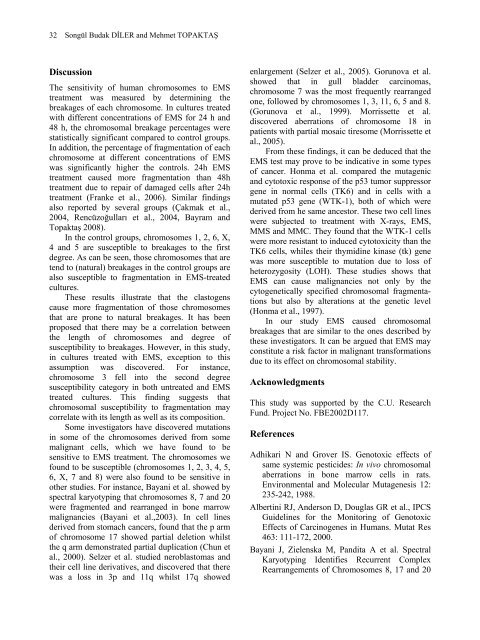Download - Journal of Cell and Molecular Biology - Haliç Üniversitesi
Download - Journal of Cell and Molecular Biology - Haliç Üniversitesi
Download - Journal of Cell and Molecular Biology - Haliç Üniversitesi
You also want an ePaper? Increase the reach of your titles
YUMPU automatically turns print PDFs into web optimized ePapers that Google loves.
32<br />
Songül Budak DİLER <strong>and</strong> Mehmet TOPAKTAŞ<br />
Discussion<br />
The sensitivity <strong>of</strong> human chromosomes to EMS<br />
treatment was measured by determining the<br />
breakages <strong>of</strong> each chromosome. In cultures treated<br />
with different concentrations <strong>of</strong> EMS for 24 h <strong>and</strong><br />
48 h, the chromosomal breakage percentages were<br />
statistically significant compared to control groups.<br />
In addition, the percentage <strong>of</strong> fragmentation <strong>of</strong> each<br />
chromosome at different concentrations <strong>of</strong> EMS<br />
was significantly higher the controls. 24h EMS<br />
treatment caused more fragmentation than 48h<br />
treatment due to repair <strong>of</strong> damaged cells after 24h<br />
treatment (Franke et al., 2006). Similar findings<br />
also reported by several groups (Çakmak et al.,<br />
2004, Rencüzoğulları et al., 2004, Bayram <strong>and</strong><br />
Topaktaş 2008).<br />
In the control groups, chromosomes 1, 2, 6, X,<br />
4 <strong>and</strong> 5 are susceptible to breakages to the first<br />
degree. As can be seen, those chromosomes that are<br />
tend to (natural) breakages in the control groups are<br />
also susceptible to fragmentation in EMS-treated<br />
cultures.<br />
These results illustrate that the clastogens<br />
cause more fragmentation <strong>of</strong> those chromosomes<br />
that are prone to natural breakages. It has been<br />
proposed that there may be a correlation between<br />
the length <strong>of</strong> chromosomes <strong>and</strong> degree <strong>of</strong><br />
susceptibility to breakages. However, in this study,<br />
in cultures treated with EMS, exception to this<br />
assumption was discovered. For instance,<br />
chromosome 3 fell into the second degree<br />
susceptibility category in both untreated <strong>and</strong> EMS<br />
treated cultures. This finding suggests that<br />
chromosomal susceptibility to fragmentation may<br />
correlate with its length as well as its composition.<br />
Some investigators have discovered mutations<br />
in some <strong>of</strong> the chromosomes derived from some<br />
malignant cells, which we have found to be<br />
sensitive to EMS treatment. The chromosomes we<br />
found to be susceptible (chromosomes 1, 2, 3, 4, 5,<br />
6, X, 7 <strong>and</strong> 8) were also found to be sensitive in<br />
other studies. For instance, Bayani et al. showed by<br />
spectral karyotyping that chromosomes 8, 7 <strong>and</strong> 20<br />
were fragmented <strong>and</strong> rearranged in bone marrow<br />
malignancies (Bayani et al.,2003). In cell lines<br />
derived from stomach cancers, found that the p arm<br />
<strong>of</strong> chromosome 17 showed partial deletion whilst<br />
the q arm demonstrated partial duplication (Chun et<br />
al., 2000). Selzer et al. studied neroblastomas <strong>and</strong><br />
their cell line derivatives, <strong>and</strong> discovered that there<br />
was a loss in 3p <strong>and</strong> 11q whilst 17q showed<br />
enlargement (Selzer et al., 2005). Gorunova et al.<br />
showed that in gull bladder carcinomas,<br />
chromosome 7 was the most frequently rearranged<br />
one, followed by chromosomes 1, 3, 11, 6, 5 <strong>and</strong> 8.<br />
(Gorunova et al., 1999). Morrissette et al.<br />
discovered aberrations <strong>of</strong> chromosome 18 in<br />
patients with partial mosaic tiresome (Morrissette et<br />
al., 2005).<br />
From these findings, it can be deduced that the<br />
EMS test may prove to be indicative in some types<br />
<strong>of</strong> cancer. Honma et al. compared the mutagenic<br />
<strong>and</strong> cytotoxic response <strong>of</strong> the p53 tumor suppressor<br />
gene in normal cells (TK6) <strong>and</strong> in cells with a<br />
mutated p53 gene (WTK-1), both <strong>of</strong> which were<br />
derived from he same ancestor. These two cell lines<br />
were subjected to treatment with X-rays, EMS,<br />
MMS <strong>and</strong> MMC. They found that the WTK-1 cells<br />
were more resistant to induced cytotoxicity than the<br />
TK6 cells, whiles their thymidine kinase (tk) gene<br />
was more susceptible to mutation due to loss <strong>of</strong><br />
heterozygosity (LOH). These studies shows that<br />
EMS can cause malignancies not only by the<br />
cytogenetically specified chromosomal fragmentations<br />
but also by alterations at the genetic level<br />
(Honma et al., 1997).<br />
In our study EMS caused chromosomal<br />
breakages that are similar to the ones described by<br />
these investigators. It can be argued that EMS may<br />
constitute a risk factor in malignant transformations<br />
due to its effect on chromosomal stability.<br />
Acknowledgments<br />
This study was supported by the C.U. Research<br />
Fund. Project No. FBE2002D117.<br />
References<br />
Adhikari N <strong>and</strong> Grover IS. Genotoxic effects <strong>of</strong><br />
same systemic pesticides: In vivo chromosomal<br />
aberrations in bone marrow cells in rats.<br />
Environmental <strong>and</strong> <strong>Molecular</strong> Mutagenesis 12:<br />
235-242, 1988.<br />
Albertini RJ, Anderson D, Douglas GR et al., IPCS<br />
Guidelines for the Monitoring <strong>of</strong> Genotoxic<br />
Effects <strong>of</strong> Carcinogenes in Humans. Mutat Res<br />
463: 111-172, 2000.<br />
Bayani J, Zielenska M, P<strong>and</strong>ita A et al. Spectral<br />
Karyotyping Identifies Recurrent Complex<br />
Rearrangements <strong>of</strong> Chromosomes 8, 17 <strong>and</strong> 20

















